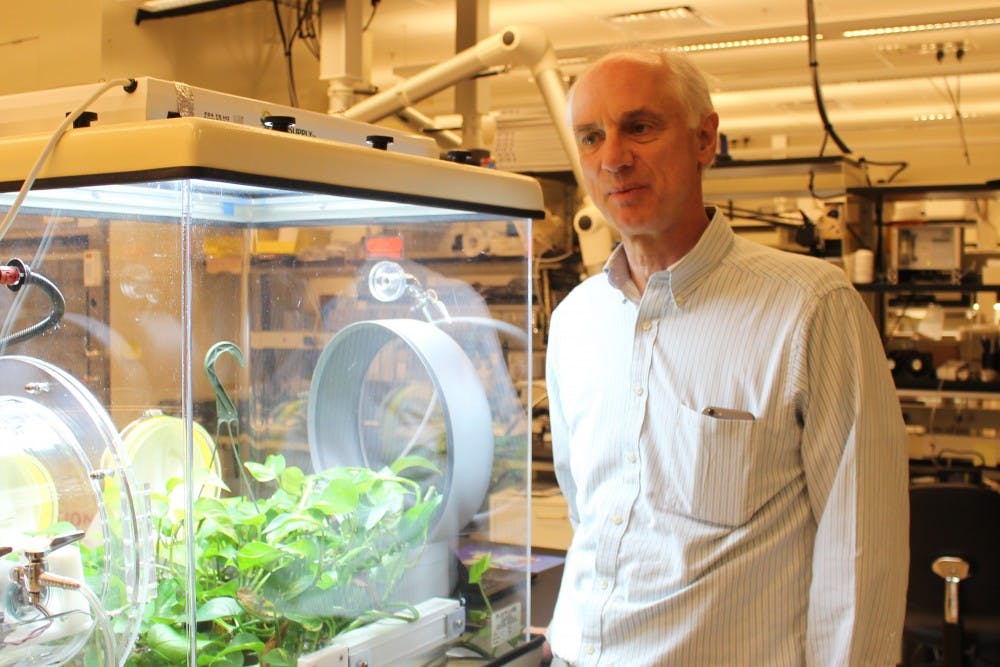Many climate change scientists say the earth hit a milestone last month in regards to the ongoing effort to reduce mankind’s environmental footprint – but it’s not an achievement to be proud of.
Carbon dioxide emissions hit an average of 400 parts per million in September, a number which cannot be naturally decreased for decades. Specialists are calling the recent milestone another sign that there needs to be change.
Klaus Lackner, director of the Center for Negative Carbon Emissions at ASU, said hitting 400 ppm represents a perpetually increasing issue with carbon dioxide production.
“We are adding about 2.5 ppm a year," he said. "It used to be in pre-industrial times that the parts per million would wobble up and down at 280 ppm. That was in the late 1700s. By 1900, we had gotten to 300 ppm. By 1958, we’d been at 315 and by 1992, we’d gotten to 356. Now we’re on an average of 400, we’ll never go below 400 for many years.”
What Lackner described was a steady increase in parts per million of carbon dioxide in the atmosphere since the 18th century. He said that while 2.5 ppm are annually added to the atmosphere, this wasn’t always the case. Before the industrial era, it was a considerably smaller 1.3 ppm annual increase.
But through his research at the Center for Negative Carbon Emissions, Lackner is attempting to reverse some of the damage.
Through various pieces of new technology, Lackner and his research team aim to take carbon dioxide out of the air. The CO2 could then be recycled into plastic, carbonated beverages or disposed of.
Without a clear conclusion on how much more CO2 the earth can take, Lackner said the most important action is to take the carbon dioxide out of the air and adopt more carbon-neutral practices.
“I think it’s very likely that over the next 50 to 100 years, we’ll have to pull 100 ppm back from the atmosphere,” he said. “That’s more CO2 than we emitted in the whole 20th century. That will stop the warming, but it won’t fix all the damages. Once you melt a glacier, there’s no unmelting it. But the alternative is that you let it keep melting.”
While Lackner's research is a potential solution, James Anderson, a sustainability professor specializing in atmospheric chemistry at ASU’s Julie Ann Wrigley Global Institute of Sustainability, said any long-lasting change can only be accomplished through human behavioral change. He also said increasing awareness through media is crucial.
“The best thing we could do is to try and educate people,” Anderson said. “People like exciting stories. But we don’t have a steady reporting for what is a steadily increasing problem. The attention-grabbing thing is what gets read, and the mundane issues aren’t highlighted.”
Like Lackner, Anderson said the repercussions of this continued increase in carbon dioxide would be major.
“One of these issues is that at some point, the Greenland ice cap is going to start to melt,” he said. “And when that happens, you’ll see the sea level begin to rise more rapidly. The people most at risk live in coastal areas. The sea level is expected to rise about half a meter. There’s an extreme prediction of one meter. If you live along the coast and it goes up, storm surges will go in further. Eventually these areas will be shallow oceans.”
Although the consequences of excess CO2 are heavy, it isn’t yet certain if Earth has already crossed the line for the process to begin. While many scientists say hitting 450 ppm is the threshold, it hasn’t been concluded.
Sustainability professor Ariel Anbar said crossing 400 is symbolically worse than it is empirically.
“It’s not like something major is going to happen just because we crossed 400,” Anbar said. “But it’s a signal in a sense. In our lifetimes, in our kids’ lifetimes, we won’t be back to below 400, so it’s a milestone in a sense. But it’s bad in the sense that it’s been a long time since that much CO2 has been in the atmosphere.”
In light of environmental issues such as increased carbon emissions, ASU has made a conscious effort to reduce its carbon footprint. By 2025, the University wants to be completely carbon neutral.
“ASU has made a concerted commitment to be carbon neutral,” Anbar said. “We see that through things like solar panels sprouting all over campus. That’s part of that commitment.”
Reach the reporter at Emmillma@asu.edu or follow @Millmania1 on Twitter.
Like The State Press on Facebook and follow @statepress on Twitter.




